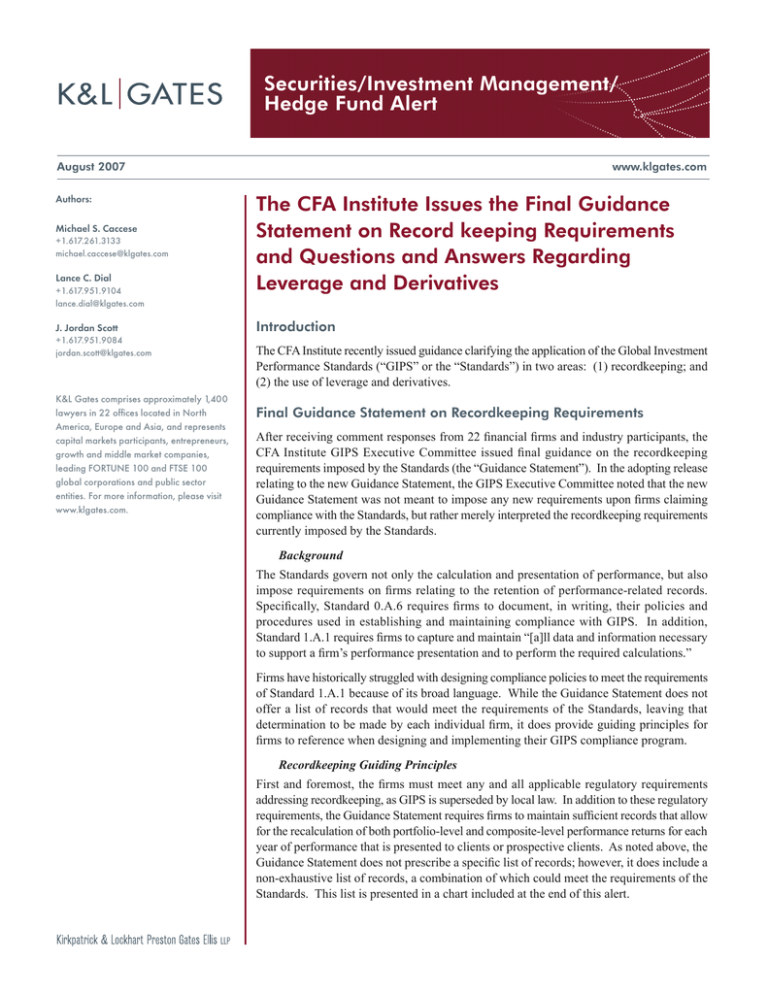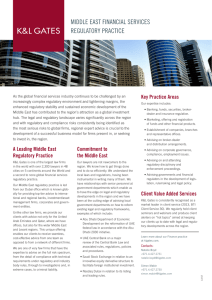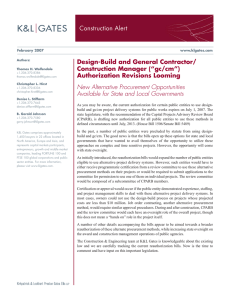
Securities/Investment Management/
Hedge Fund Alert
August 2007
Authors:
Michael S. Caccese
+1.617.261.3133
michael.caccese@klgates.com
Lance C. Dial
+1.617.951.9104
lance.dial@klgates.com
J. Jordan Scott
+1.617.951.9084
jordan.scott@klgates.com
K&L Gates comprises approximately 1,400
lawyers in 22 offices located in North
America, Europe and Asia, and represents
capital markets participants, entrepreneurs,
growth and middle market companies,
leading FORTUNE 100 and FTSE 100
global corporations and public sector
entities. For more information, please visit
www.klgates.com.
www.klgates.com
The CFA Institute Issues the Final Guidance
Statement on Record keeping Requirements
and Questions and Answers Regarding
Leverage and Derivatives
Introduction
The CFA Institute recently issued guidance clarifying the application of the Global Investment
Performance Standards (“GIPS” or the “Standards”) in two areas: (1) recordkeeping; and
(2) the use of leverage and derivatives.
Final Guidance Statement on Recordkeeping Requirements
After receiving comment responses from 22 financial firms and industry participants, the
CFA Institute GIPS Executive Committee issued final guidance on the recordkeeping
requirements imposed by the Standards (the “Guidance Statement”). In the adopting release
relating to the new Guidance Statement, the GIPS Executive Committee noted that the new
Guidance Statement was not meant to impose any new requirements upon firms claiming
compliance with the Standards, but rather merely interpreted the recordkeeping requirements
currently imposed by the Standards.
Background
The Standards govern not only the calculation and presentation of performance, but also
impose requirements on firms relating to the retention of performance-related records.
Specifically, Standard 0.A.6 requires firms to document, in writing, their policies and
procedures used in establishing and maintaining compliance with GIPS. In addition,
Standard 1.A.1 requires firms to capture and maintain “[a]ll data and information necessary
to support a firm’s performance presentation and to perform the required calculations.”
Firms have historically struggled with designing compliance policies to meet the requirements
of Standard 1.A.1 because of its broad language. While the Guidance Statement does not
offer a list of records that would meet the requirements of the Standards, leaving that
determination to be made by each individual firm, it does provide guiding principles for
firms to reference when designing and implementing their GIPS compliance program.
Recordkeeping Guiding Principles
First and foremost, the firms must meet any and all applicable regulatory requirements
addressing recordkeeping, as GIPS is superseded by local law. In addition to these regulatory
requirements, the Guidance Statement requires firms to maintain sufficient records that allow
for the recalculation of both portfolio-level and composite-level performance returns for each
year of performance that is presented to clients or prospective clients. As noted above, the
Guidance Statement does not prescribe a specific list of records; however, it does include a
non-exhaustive list of records, a combination of which could meet the requirements of the
Standards. This list is presented in a chart included at the end of this alert.
Securities/Investment Management/
Hedge Fund Alert
The Guidance Statement also discusses the general
recordkeeping obligations of firms in connection with
their GIPS-compliance programs. Specifically, firms
must maintain records supporting the rationale for
assigning portfolios to their composites (or excluding
portfolios from all composites). Documentation of
the firm’s composite definitions and each account
guideline (e.g., investment management agreements
or client reports) could satisfy this requirement if it
supports the composite inclusion or exclusion decision.
Although not mentioned in the Guidance Statement,
firms could also rely upon internal documentation
generated at the time of the composite inclusion or
exclusion determination.
Finally, firms are required to maintain records
supporting their claim of compliance on a firmwide basis, including current and historic policies
and procedures relating to the firm’s compliance with
GIPS. These records could include:
•the current and historic firm definition;
•total firm assets for all periods presented;
•composite list and composite definitions including creation dates; and
•compliant presentations and supporting information for all composites.
The Guidance Statement also offers firms some
flexibility in the maintenance of these records. For
example, firms are permitted to maintain their records
in hard copy or in electronic storage and to maintain the
minimum records sufficient for the firm to recalculate
the required returns. The Guidance Statement offers
the example of retaining annual portfolio transaction
reports in lieu of individual monthly detail reports.
However, the Guidance Statement cautions firms to
maintain as much data as possible where there is any
doubt and to seek advice as to what data to maintain.
Firms are not permitted to present performance for
any periods for which the firm does not have records
meeting the GIPS recordkeeping requirements,
unless the firm’s records were lost in connection with
a catastrophic event, e.g., earthquake, flood, fire or
terrorist attack.
Guidance Statement Effective Date
Firms must comply with the new Guidance Statement
beginning October 31, 2007, but the Guidance
Statement is not effective retroactively because the
Guidance Statement does not identify any records or
documents firms were not already required to maintain.
Firms are encouraged to evaluate their historical
documentation in view of the Guidance Statement.
Leverage and Derivatives Questions and
Answers
With the increasing use of leverage and derivatives in
the investment marketplace, the GIPS Interpretations
Subcommittee of the CFA Institute sought to provide
additional guidance through its “Q & A Database”
(available at: http://www.gips standards.org/programs/
faqs/index.asp – Select “Leverage/Derivatives” from
the drop down menu). The Database now provides
various specific examples for portfolio valuation.
Examples are provided for valuing portfolios that
include options, margin borrowing, long futures, short
futures, long and short futures, short options, and a
market neutral strategy.
In sum, the new questions and answers regarding
leverage and derivatives are designed to ensure that
firms appropriately account for the effects of leverage
and derivatives in their performance calculations
including the effect of any related income or expenses.
For example, the performance of a portfolio investing
in long futures should account not only for any
appreciation in the notional value of the futures (and
other investments), but also the interest received
from the deposited margin. On the other hand, the
performance of a portfolio borrowing on margin should
include the appreciation on investments reduced by
the margin interest paid. Each specific question and
answer includes an explanation and an illustration of
the formula employed for the calculation.
August 2007 | Securities/Investment Management/
Hedge Fund Alert
Example List of Records
Records for Recalculation of
Portfolio-Level Returns
• associated bank/custodial statements and
reconciliations;
• portfolio statements of assets and valuations,
including pricing calculations for securities such
as:
• not readily priced securities; or,
• thinly-traded securities;
• portfolio transactions reports;
• outstanding trades reports;
Records for Recalculation of
Composite-Level Returns
• investment management fee information
• portfolios included in/excluded from the
composite;
• when each portfolio entered (and exited, if
applicable) the composite;
• each portfolio’s return;
• market value used to weight each portfolio
(Beginning Market Value (“BMV”) or BMV
plus weighted cash flows);
• income received/earned reports;
• number of portfolios in the composite and
the composite’s assets at the end of each period
presented;
• accrued income reports;
• dispersion calculation data; or
• foreign or other withholding tax reclaim reports;
• investment management fee
• corporate action reports;
• cash flow/weighted cash flow reports;
• information on calculation methodology used;
• information provided by a third party (for
example, the Sponsor in a wrap fee/SMA
relationship) where it may be necessary for a firm
to take additional steps to ensure the information
provided by the third party can be relied on to
meet the requirements of the Standards; or
K&L Gates comprises multiple affiliated partnerships: a limited liability partnership with the full name Kirkpatrick & Lockhart Preston Gates Ellis LLP qualified
in Delaware and maintaining offices throughout the U.S., in Berlin, and in Beijing (Kirkpatrick & Lockhart Preston Gates Ellis LLP Beijing Representative
Office); a limited liability partnership (also named Kirkpatrick & Lockhart Preston Gates Ellis LLP) incorporated in England and maintaining our London
office; a Taiwan general partnership (Kirkpatrick & Lockhart Preston Gates Ellis) which practices from our Taipei office; and a Hong Kong general
partnership (Kirkpatrick & Lockhart Preston Gates Ellis, Solicitors) which practices from our Hong Kong office. K&L Gates maintains appropriate registrations
in the jurisdictions in which its offices are located. A list of the partners in each entity is available for inspection at any K&L Gates office.
This publication/newsletter is for informational purposes and does not contain or convey legal advice. The information herein should not be used or relied
upon in regard to any particular facts or circumstances without first consulting a lawyer.
Data Protection Act 1998—We may contact you from time to time with information on Kirkpatrick & Lockhart Preston Gates Ellis LLP seminars and with our
regular newsletters, which may be of interest to you. We will not provide your details to any third parties. Please e-mail london@klgates.com if you would
prefer not to receive this information.
©1996-2007 Kirkpatrick & Lockhart Preston Gates Ellis LLP. All Rights Reserved.
August 2007 |







